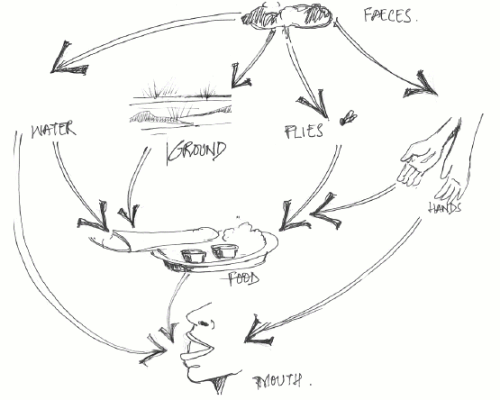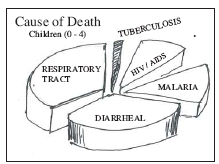|
|
|
One
gram of faeces could
contain 10 million viruses, 1 million bacteria, a thousand parasite
cysts and a hundred worm eggs. And every minute, 1.1 million litres of
raw sewage are dumped into the Ganges river alone. And this is just the
tip of the iceberg dump!
In
fact every day 2,00,000 metric tonnes is added to the surface of the
earth in open defecation. This waste finds its way into the soil and
into water bodies. Thus infecting our very source of life.

Excreta
mixed with water
contaminate the
groundwater. This water is used by us for cooking, drinking, bathing
and washing clothes. Polluted water and inadequate sanitation cause
5-7% percent of all epidemics especially among children.
Several
diseases like
diarrehoea, cholera, typhoid fever, hepatitis-A, dysentery and
guinea-wormdisease spread in the absence of proper sanitation and
adequate treatment or disposal of human excreta. The excreta when left
on the surface attracts flies and insects responsible for spreading
diseases by contaminating our food or water.
|
|
|
A Diarrhoea of
Death!
Over
2 million people die
annually only to diarrhoea, wherefrom most are under the age of five.
Every day approximately 6000 children die to diarrhoea related diseases.
Poor
sanitation is directly
responsible for the high incidence of diarrheoeal disease.
3
billion people lack safe sanitation
2.4
billion people have no access to basic sanitation
5.7%
of diseases are due to poor water sanitation and hygiene
Nearly
4 children die every minute from unsafewater and inadequate sanitation.

"In
India there
are 700 million people who do not have access to safe and hygienic
toilets. The waterborne diseases this causes kill 500,000 children
every year, mostly from diarrhea,"
said Bindeshwar Pathak, the head of the Sulabh Sanitation and Social
Reform Movement.
|
Top
Sanitation
and
Health
The World
Health
Organization (WHO) carried out an assessment of the global disease
burden from unsafe water, sanitation and hygiene, as part of a larger
initiative to assess the impact of 25 risk factors in a standardized
manner (WHO, 2002; Prűss et al., 2002; Murray and Lopez, 1996a). It
also commissioned systematic literature reviews of the fraction of the
estimated burden of four water-associated vector-borne diseases that
can be attributed to water resources development (irrigation schemes
and dams) (Keiser et al., 2005a; Erlanger et al., 2005; Keiser et al.,
2005b; Steinmann et al., 2006).
The
method
presented in this guide proposes to roughly estimate the impact of
unsafe water, inadequate sanitation and poor hygiene on the burden of
diarrhoeal disease. In case the coverage in improved sanitation
services is below 98%, it is likely that the fraction of diarrhoea
attributable to WSH ranges between 70 and 90%. This is due to the fact
that even with only 2% of inadequately disposed excreta, the level of
faecal-oral pathogens in the environment is likely to be high enough
that water, sanitation and hygiene play the dominant role in disease
transmission.
Water,
sanitation and hygiene, Environmental Burden of Disease Series, No. 15
by Lorna Fewtrell and others, WHO, Public Health and the Environment,
Geneva 2007 (need to index, downloaded)
Diarrhoea
is caused by a variety of micro-organisms including viruses, bacteria
and protozoans. Diarrhoea causes a person to lose both water and
electrolytes,, which leads to dehydration and, in some cases, to death.
About 4 billion
cases
of diarrhoea per year cause 1.8 million deaths, over 90 per cent of
them (1.6 million) among children under five. Repeated episodes of
diarrhoeal disease makes children more vulnerable to other diseases and
malnutrition.
Common water and
sanitation-related
diseases,
Unicef, 18 February 2008 [C.eldoc1/d70d/common-water-san-rel-disease.html]
Why
Sanitation
is important? - refer 'Sanitation and the Economy Therese Dooley,
Deccan Herald 20 nov 2007 [C.eldoc1/d70d/20nov07dch1.html]
- According
to UNDP's Human Development Report 2006, access to a flush toilet
reduced the risk of infant death by 59% in Peru and 57% in Egypt.
- Poverty
has meant that 120 million homes in the country, or 700 million people,
have to make do without proper toilets, leading to diarrhoea killing
450,000 infants every year.
- UNDP
policy specialist Arunabha Ghosh said: "No access to sanitation means
people draw water for drinking and cooking from rivers, lakes and
ditches fouled with human and animal excrement.
- "One
in
three Indians don't have access to toilets.
- Two
out
of three people in South Asia lack basic sanitation leading to loss of
$36 billion in productivity.
- From
1990
to 2004,South Asia provided sanitation to 25 million additional people
every year. This needs to be increased to 43 million by 2015.
- According
to reported data, Mumbai enjoys a safe water coverage rate of more than
90%. The report calls it "almost certainly exaggerated".
- The
report estimates almost half of the city's 18 million people live in
temporary slums who don't figure in municipal data.
- On
Dharavi, it says: "There is an estimated one toilet for every 1,440
people.
- In
the
rainy season, streets, lacking drainage, become channels for filthy
water carrying human excrement.
- People
in
Dharavi relie on wells, tankers or unsafe sources for their drinking
water. In a typical case, 15 families share one tap that works for two
hours a day."
- The
report hails Bengal's efforts in improving toilet facilities. "In 1990,
when the state launched its rural sanitation drive in Midnapore,
coverage rates were less than 5%. The district now has 100% coverage.
Across the state, 2 million toilets came up in the last five years,
increasing coverage from 12% in 1991 to over 40% today."
'Toilets
can save 1
million kids from diarrhoea death' Kounteya Sinha [
C.eldoc1/d70d/10nov06toi1.pdf]
Sanitation interventions to reduce people's exposure to disease by
providing a clean environment in which to live, measure to break the
cycle of disease. This usually includes disposing of or hygienic
management of human and animal excreta, refuse, and wastewater, the
control of disease vectors and the provision of washing facilities for
personal and domestic hygiene. Sanitation involves both behaviours and
facilities which work together to form a hygienic environment.
Sanitation Promotion- WSSCC working Group on Promotion of Sanitation,
edited by Mayling Simpson-Hebert and Sara Wood, WHO, 1998 [R.D70d.38]
Sanitation is that part of health education which includes practical
aspect of storing and handling food safely, making water fit to drink,
disposing of waste and maintaining a healthy home environment.
Food, Environment and Health, A guide for Primary School Teachers by
Trefor Williams and others, WHO, Geneva, 1990 [B.E62.W1]
Top
|

